Related Research Articles
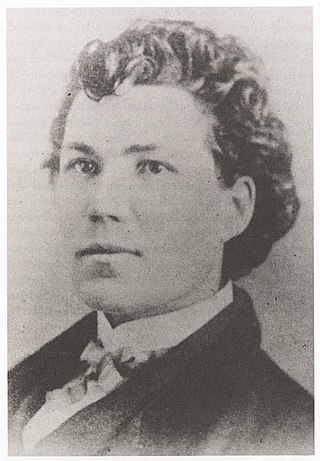
Sarah Emma Edmonds was a British North America-born woman who claimed to have served as a man with the Union Army as a nurse and spy during the American Civil War. Although recognized for her service by the United States government, some historians dispute the validity of her claims as some of the details are demonstrably false, contradictory, or uncorroborated.

Albert D. J. Cashier, born Jennie Irene Hodgers, was an Irish-born American soldier who served in the Union Army during the American Civil War. Cashier adopted the identity of a man before enlisting, and maintained it until death. Cashier became famous as one of at least 250 soldiers who were assigned female at birth and enlisted as men to fight in the Civil War. The consistent and nearly lifelong commitment to a male identity has prompted some historians to believe that Cashier was a trans man.

Sarah Malinda Pritchard Blalock was a female soldier during the American Civil War. Despite originally being a sympathizer for the right of secession, she fought on both sides. She followed her husband, William Blalock, and joined the CSA's 26th North Carolina Regiment, disguising herself as a young man and calling herself Samuel Blalock. The couple eventually escaped by crossing Confederate lines and joining the Union partisans in the mountains of western North Carolina. During the last years of the war, she was a pro-Union marauder raiding the Appalachia region. Today she is one of the most remembered female combatants of the Civil War.
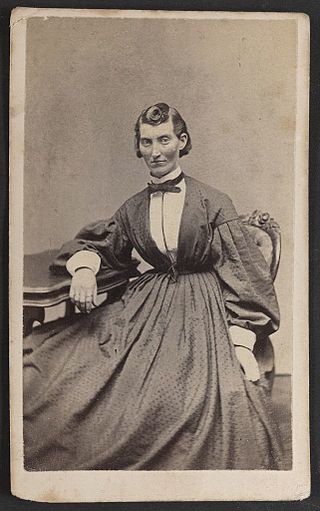
Frances Louisa Clayton, also recorded as Frances Clalin, was an American woman who purportedly disguised herself as a man to fight for the Union Army in the American Civil War, though many historians now believe her story was likely fabricated. Under the alias Jack Williams, she claimed to have enlisted in a Missouri regiment along with her husband, and fought in several battles. She claimed that she left the army soon after her husband died at Stones River.
Elizabeth Compton was a woman soldier fighting for the Union in the American Civil War. She enlisted at the age of 14, and served in seven different regiments until the conclusion of the war, thus holding the record for reenlisting in the most regiments. Compton fought at Mill Springs, Fort Donelson, Shiloh, and Gettysburg until the conclusion of the Civil War before moving to Ontario, Canada.

The 7th Rhode Island Infantry Regiment was an infantry regiment of the Union Army during the American Civil War.

The 20th Massachusetts Volunteer Infantry, also known as the "Harvard Regiment", was a regiment of infantry in the American Civil War. The regiment was so nicknamed because the officers of the 20th were young Harvard graduates. In addition, some, but not all, of the private soldiers had attended Harvard. The 20th was organized at Camp Meigs in Readville, August 29 to September 4, 1861. After training they left Massachusetts for Washington, D. C., September 4. They would fight until the war's conclusion being mustered out on July 16 and discharged July 28, 1865. Fogel et al's Union Army Data urban sample suggests perhaps as many as two-thirds of the regiment's enlisted were immigrants with Irish immigrants making up half of the regiment's total.
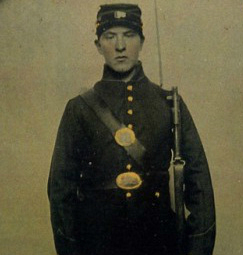
Sarah Rosetta Wakeman was an American female soldier who served in the Union Army during the American Civil War under the male name of Lyons Wakeman. Wakeman served with Company H, 153rd New York Volunteer Infantry. Her letters written during her service remained unread for nearly a century because they were stored in the attic of her relatives.

Lorinda Anna Blair Etheridge was a Union nurse and vivandière who served during the American Civil War. She was one of only two women to receive the Kearny Cross. She was inducted into the Michigan Women's Hall of Fame in 2010.
The 20th Ohio Infantry Regiment was an infantry regiment in the Union Army during the American Civil War.
The 58th Ohio Infantry Regiment was an infantry regiment in the Union Army during the American Civil War.
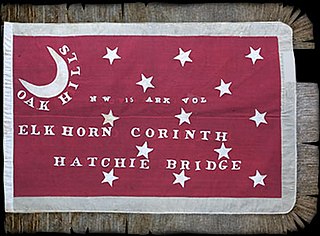
The 15th Arkansas Infantry Regiment, also known as the "Northwest regiment", was an infantry formation of the Confederate States Army during the American Civil War. It was originally formed as the 3rd Arkansas Infantry Battalion. After receiving the requisite ten companies, the battaltion was redesignated as the 21st Arkansas Infantry Regiment. Upon discovery that there was already another "21st Arkansas," the Northwest Regiment was again redesignated as the 15th Arkansas Infantry Regiment. This was the third Arkansas regiment to bear the designation "15th Arkansas." The others are Johnson's and Josey's Arkansas infantry regiments. Members of the Northwest Regiment fought both west and east of the Mississippi River before participating in the Vicksburg campaign, surrendering at Vicksburg in July 1863. After being paroled and exchanged, the regiment was consolidated with other state units to form the 1st Consolidated Arkansas Infantry Regiment.
This is a timeline of women in warfare in the United States before 1900.This list includes women who served in the United States Armed Forces in various roles. It also includes women who have been Warriors and fighters in other types of conflicts that have taken place in the United States. This list should also encompass women who served in support roles during military and other conflicts in the United States before the twentieth century.
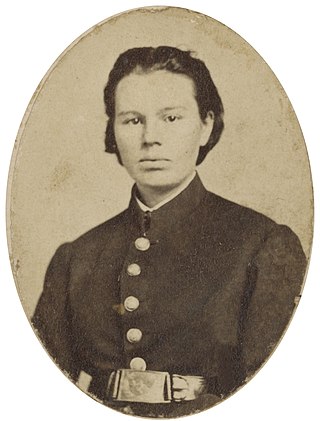
Frances Hook claimed that she, disguised as a man, enlisted as a soldier in the Union Army during the U.S. Civil War. She stated her aliases were Pvt. Frank Miller, Frank Henderson, Frank Martin and Frank Fuller. However, the enlistment records for the units in which she claimed to have served show no evidence of those aliases, nor any record to corroborate her story.
Charlotte Hatfield, also known as Charley Hatfield or "Mountain Charley", was a female soldier for the Union Army during the American Civil War.
Nellie Graves was a female soldier who served, in secret, in the Union Army during the American Civil War alongside her close friend Fanny Wilson. Both saw action at the battles of Fredericksburg and Chancellorsville. Their genders were shortly discovered while they were being treated for an illness. Both were discharged and went their separate ways for the rest of the war. Wilson chose to reenlist in disguise again. There is some speculation as to whether Graves did the same, but if she had reenlisted, she was not discovered for a second time.

The 100th Regiment Pennsylvania Volunteer Infantry was an infantry regiment that served in the Union Army during the American Civil War.
Mary Owens fraudulently claimed to have served in disguise as a male Union soldier during the American Civil War.
Frances Elizabeth Quinn was an Irish-born Union Civil War soldier who fought in both the infantry and cavalry. She enlisted over five separate times throughout the war and the country. Each time she was eventually discovered to be a woman and discharged from the military.
References
- 1 2 3 4 Eggleston 2003 [ page needed ]
- 1 2 Blanton 2002 [ page needed ]
- ↑ Allard 2011.
Works cited
- Allard, John (2011-12-15). "Women of the Civil War, by Larry Eggleston: Fanny Wilson and Nellie Graves: Friends, and Soldiers". womenincivilwarjohn.blogspot.com. Archived from the original on 2014-07-15.
- Blanton, DeAnne (2002). They fought like demons : women soldiers in the American Civil War . Baton Rouge: Louisiana State University Press. ISBN 9780807128060. OCLC 315917223.
- Eggleston, Larry (2003). Women in the Civil War : extraordinary stories of soldiers, spies, nurses, doctors, crusaders, and others . Jefferson, North Carolina: McFarland & Company. ISBN 9781476607818. OCLC 872371006.